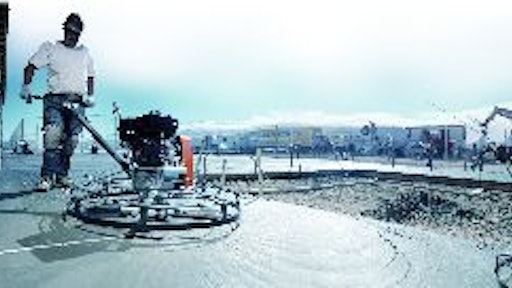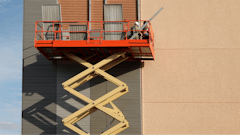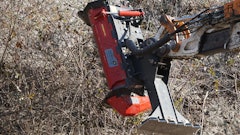
With margins tight in today's economy, it's imperative your equipment is well taken care of and running at the height of productivity. When your finishing trowel is running the way it should, you'll see fuel efficiency and a safe, reliable machine that keeps on running at the jobsite.
A smooth finish
Since the purpose of a trowel is to flatten a floor, failing to properly maintain your trowel will negatively affect a floor's finish. A trowel with a poorly maintained engine might sputter or jerk on the slab, resulting in dents on the floor, commonly referred to in the industry as "furrows." In addition, inability to properly pitch your blades, a bent arm or spider, or a worn out blade can cause a swirling pattern on the floor.
Grease, oil and fuel leaks will also negatively affect the finish. "Troweling begins after most of the bleed water from the slab has evaporated," explains Ed Varel, engineering project manager with Stone Construction Equipment. "If oil gets on the slab, it's going to cause problems on the top. The remaining bleed water will evaporate and leave the oil on the slab, creating a finish problem."
Cleanliness is also important in achieving a smooth finish. "A poorly maintained trowel that isn't clean is going to drop dry concrete on the floor and scratch the polished surface on those last few passes. There is no way to go back and repair that damage," says Ben Wiese, product manager with Multiquip and Whiteman trowels.
Routine maintenance
The daily/weekly/monthly/annual maintenance guidelines in this article should be examined and customized to your rental company's trowel utilization. Check with your trowel manufacturer's maintenance guidelines to determine the best maintenance intervals for your rental company's trowel utilization.
Daily:
One of the most important daily maintenance items you can do to keep your trowel in tip-top shape is to instruct customers to powerwash it at the end of each use. This will keep it looking professional and free from excess grease or other debris that might gum up moving parts. And your customers won't have to worry about dried concrete dropping onto their floor. For when the machine is back in your shop, there are cleaning solutions designed especially for removing dried-on concrete as well as products you can apply to your trowel to make it easier to clean at the end of each rental.
Greasing and maintenance checks can be easily performed after each rental. This will ensure your trowel is ready to go for the next customer.
The concrete slab is a tough environment for your trowel engine, and it's important to make sure you're taking a look at the engine components every day. "One of the most common problems I see with trowels is people aren't checking the air filters," says Troy Halverson, team leader of the product support department with Wacker Neuson Corp. "The concrete dust will choke the engine and the machine will have less power."
Examine the air filter every day for potential clogging. With a liquid-cooled engine you'll want to check your coolant level daily. On all engines you should check the oil level and for oil leaks.
Before turning on the machine, the operator should perform a visual inspection. "Make sure everything to the eye is tight, safety guards are in place and all the parts are there. You want the machine to be safe to work on and others to be around," Halverson says.
Scott Brening, product manager with Husqvarna Construction Products, adds, "Check the bolts that attach to the blades. If these bolts were loose it would be very dangerous when the rotors begin to turn. It could also affect the balance of the machine and make the trowel wobble during use."
Brening also suggests, "Just as we do in our cars, it's important to let the trowel motor idle in the morning before putting it on the concrete."
Weekly:
Weekly inspections emphasize a closer look at your trowel's bottom end. A bent spider arm - the part of the trowel that holds the blades or pans - can result in a swirling pattern or waviness to the finish. An experienced operator can recognize these problems during operation, but noticing these problems during a job can often be too late to fix them in time to save the slab without re-work. Most manufactures offer spider assemblies with adjustable arms. This allows you to compensate for a bent arm and ensure your blades are all working on the same plane.
Another maintenance item you should add to your weekly checklist concerns the drive belt. Rubber drive belts will disintegrate with heat. Make sure your trowel's belt is in good condition, and change it when you begin to notice wear. "A lot of people use third-party belts and usually that's not a problem, but with variable-speed trowels with a torque-compensating drive system, those belts are very specific to the application, and you need an exact match," Halverson warns.
Monthly:
Monthly maintenance items take a step beyond your daily engine maintenance checks. In other words, while you're checking oil levels and air filters or coolant daily, you should plan on monthly replacement or cleaning. Be sure to examine your engine manufacturer's recommendations to determine the best engine maintenance schedule. Not all engines are the same - air-cooled engines will generally need more frequent oil changes than liquid-cooled engines.
Because the concrete jobsite can be very demanding on an engine, with dust and the high demand placed on a trowel engine, leading engine manufacturers offer features that make trowel engine maintenance easier. Cyclonic air filter systems are designed to work in high-dust environments, and some models can be equipped with restriction indicators that allow you to see if the air filter is dirty or clogged. These systems, while improving the performance of the air filter, also require their own maintenance.
"Many of these machines have a remote air cleaner - a canister-type air cleaner connected to the engine by a hose - so there are a couple joints, a couple hose clamps and a piece of rubber tubing there, all of which are potential leak points. Those things should be inspected regularly to make sure you're not short circuiting the air cleaner," says Andy Traxel, Engineering Manager with Briggs & Stratton Daihatsu, LLC.
Another engine feature designed for easy maintenance is an oil alert system, which notifies the operator if the engine oil level drops below a safe operating level.
Traxel says if you're concerned about maximizing efficiency and keeping maintenance costs down, you might want to take your maintenance to the next level of sophistication, especially if you're running a fleet of trowels. "I think the way to be really sure of maintenance and care of a machine, and to avoid spending any more money than you have to on oil and filters and shop labor, is to have an oil analysis program going for your equipment," Traxel says. "I think if someone did some oil analysis every 50 hours on a couple of machines they would understand the trend for the degradation of the oil in the engine, and that would tell them what an appropriate service interval would be."
Joel Borowski, manager of distributor & service operations with Honda Engine Sales Group, notes, "It is always best to run the engine for two or three minutes to warm it up before changing the oil. Warm oil drains better and faster, plus running it before changing the oil will help remove more of the debris that is suspended in the oil." Check your engine manufacturer's recommendations for oil type and weight.
When it comes to buying coolant for your engine, be sure to read the labels. With the number of coolant blends available on the market, you might think you're buying a blend when you're actually buying a straight coolant. And never think straight water is going to cut it for a hard-working trowel.
Borowski says if you're working with a trowel equipped with an air-cooled engine, it's important to the engine's longevity that the machine is not operating in a confined area. "Cool air needs to be drawn in and hot air needs to have a clear path to exit the engine," Borowski explains. "Any restrictions to cool air getting to the engine or allowing the hot air to flow away from the engine will cause the engine to overheat. That can and will drastically shorten engine life."
Annual:
In addition to routine maintenance, there are a few annual checks you'll want to add to your maintenance schedule. Again, based on your manufacturer's suggestion for annual use, which is typically considered 300 to 500 hours of use, these are items you might end up doing once a year or a few times a year.
One annual maintenance item is changing your gear box oil. "There's a lot of friction in these gear boxes and a little bit of wear on those gears. You want to get that metal out of there or it's going to accelerate wear inside the gear box," Halverson says.
You should also pull out your blade arms and ensure proper adjustment, plan on replacing belt drives at least once a year, and closely examine your trowel's blade-tilt mechanism. With walk-behind trowels, Halverson suggests annual maintenance on the throttle cable. "Throttle cable maintenance is something people don't think about until it sticks on them and they can't throttle down. Especially in the north where it gets cold in the winter and contractors are pushing the season, all you need is a drop or two of water in the throttle cable and it can freeze up and the trowel won't throttle up or down." Halverson uses a synthetic grease in the throttle cable, which he says tends not to attract water as much as a petroleum-based oil can.






























